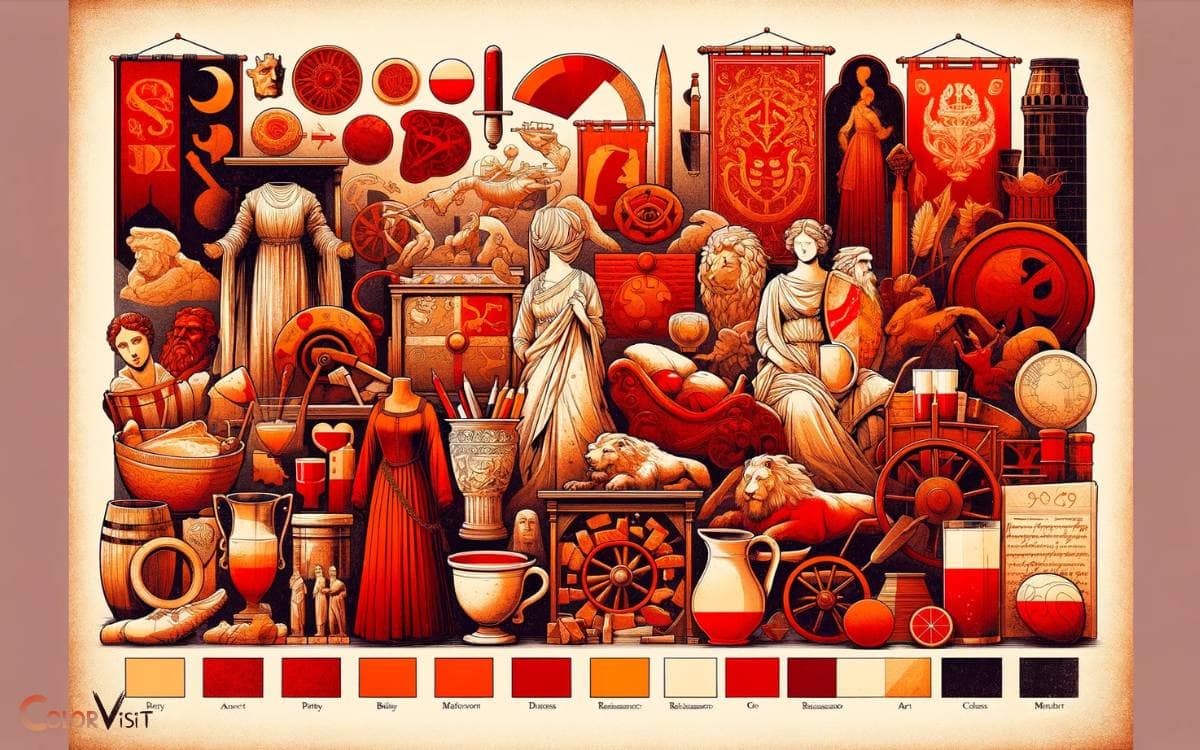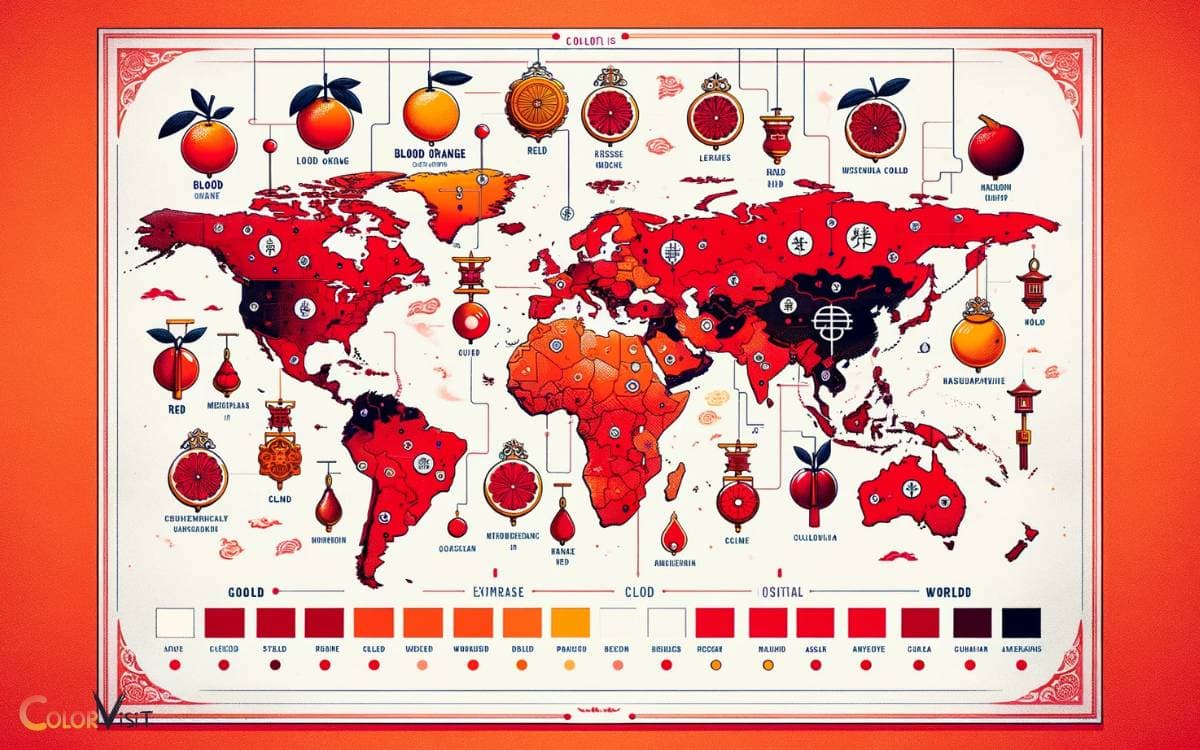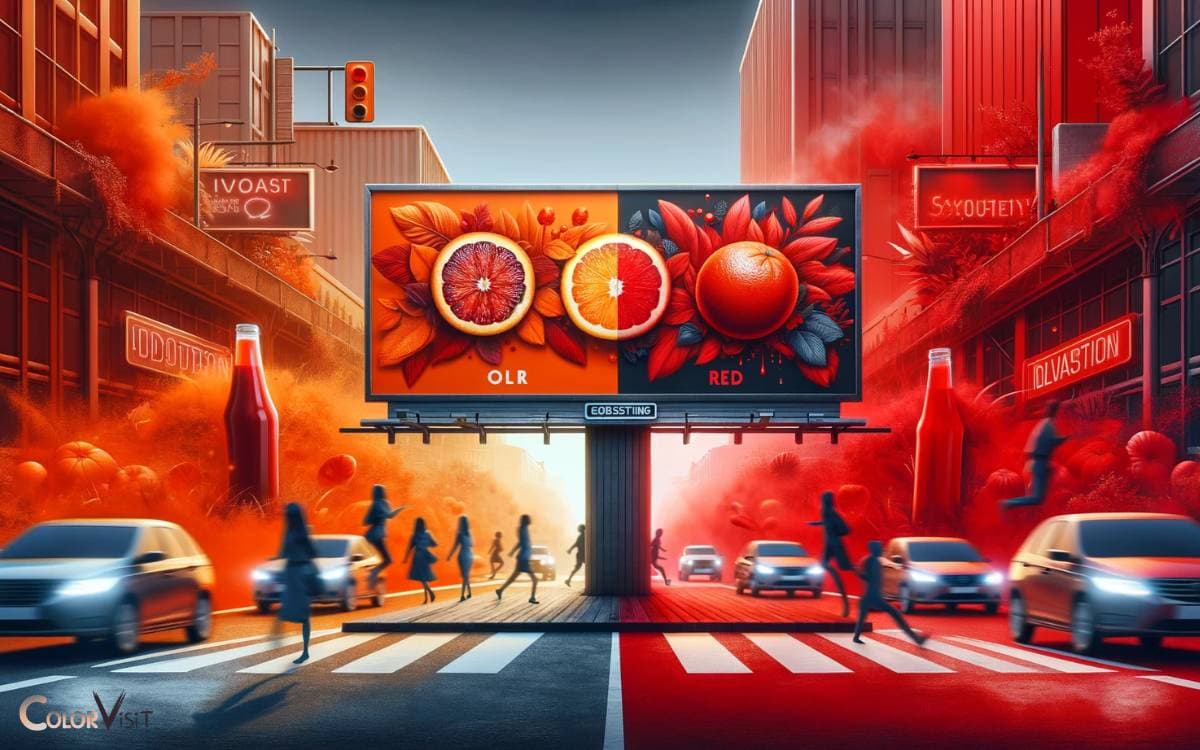Blood Orange Color Vs Red: Unleashing the Vibrancy!
The distinction between blood orange and red in the color spectrum is not just a matter of hue but also of profound psychological and cultural significance.
Blood orange, a rich and vibrant color, embodies a unique blend of red’s intensity with the warm, comforting glow of a sunset.
This color, with its deep, almost crimson shade, captures the essence of both passion and serenity, making it a captivating choice for various applications in art, design, and fashion.
On the other hand, red, a primary color, is universally recognized for its boldness and is associated with strong emotions such as love, anger, and danger.
For example, in marketing, a blood orange color might be used to evoke a sense of luxury and exclusivity, while red could be chosen to grab attention and evoke a sense of urgency.
Understanding the differences between blood orange and red is crucial for professionals in fields such as marketing, design, and art.
By recognizing the unique qualities and psychological impacts of each color, individuals can make informed decisions that enhance the appeal and effectiveness of their projects or brands.
Colors like blood orange and red do more than just decorate; they communicate. Blood orange whispers of luxury and depth, while red shouts of passion and danger. Each color tells its own story, inviting us to listen.
Key Takeaway
Defining Blood Orange
The blood orange, scientifically known as Citrus sinensis, distinguishes itself through its deep maroon, almost crimson flesh, a result of the compound anthocyanin, which is not typically present in other citrus fruits.
This unique pigment is synthesized through a complex biochemical pathway, influenced by environmental factors such as temperature and light exposure during the fruit’s maturation process.
Anthocyanins, belonging to the flavonoid class of phytochemicals, have been extensively studied for their antioxidant properties, contributing not only to the distinctive coloration of the blood orange but also offering potential health benefits.
The presence and concentration of anthocyanins thus not only define the aesthetic and nutritional profile of the blood orange but also underscore its significance in agricultural innovation and the development of functional foods.
Understanding Red
As we transition to an examination of red, it is crucial to recognize the spectrum of shades this color encompasses, each possessing distinct characteristics and applications.
The emotional impact of red is profound, influencing perceptions and behaviors in diverse contexts, from marketing to art.
Additionally, red’s manifestation in nature, from the blush of autumn leaves to the vibrant plumage of certain avian species, underscores its significance in the natural world and its influence on human culture.
Shades of Red
Delving into the spectrum of red reveals a rich tapestry of hues, each distinguished by specific wavelengths and saturation levels that contribute to their unique visual perception.
This exploration is not merely about identifying colors but understanding the intricacies that make each shade of red distinct and how they interact with human perception and technological applications.
- Crimson: Characterized by a deep, vivid red with a slightly blue undertone, resulting from a wavelength of approximately 620–750 nm.
- Scarlet: A bright red with a slight hint of orange, falling into the 605–620 nm wavelength range, known for its high saturation.
- Vermilion: Defined by its vibrant, slightly orange tone, existing within a 630 nm wavelength, offering a medium to high saturation.
- Carmine: This deep red shade, leaning towards a cooler palette, is identified within the 700 nm wavelength, noted for its significant depth and intensity.
Each of these shades plays a crucial role in various fields, from design to consumer electronics, highlighting the importance of precise color identification and application in innovation-driven industries.
Red’s Emotional Impact
Exploring the spectrum of red not only unveils a variety of hues but also invites an examination of the profound emotional impacts these shades exert on human psychology and behavior.
Red, often associated with passion, energy, and urgency, plays a pivotal role in influencing human emotion and decision-making processes.
Its potency in drawing attention makes it a valuable tool in marketing, signaling, and design, leveraging its inherent ability to evoke strong responses ranging from excitement to aggression.
Analytically, the nuances in red’s impact can be dissected through psychophysiological studies, demonstrating its capacity to increase heart rate and create feelings of urgency.
For innovators, understanding the subtle variations in emotional response elicited by different tones of red is crucial in designing environments, products, and experiences that harness the full spectrum of human emotion.
Red in Nature
In the realm of nature, the color red manifests through a myriad array of phenomena, ranging from the vibrant plumage of birds to the deep hues of autumn leaves, each instance offering a unique opportunity to analyze its impact on both the environment and human perception.
- Cardinal Birds: Their vivid red feathers serve as a striking example of sexual selection, where brighter plumage correlates with fitness and attractiveness.
- Red Maple Trees: The fiery red foliage in autumn provides insights into the adaptive significance of leaf coloration for energy conservation.
- Coral Reefs: The presence of red pigmentation in certain corals underlies a complex relationship with sunlight absorption and symbiotic algae.
- Tomatoes: The red coloring, attributed to lycopene, illustrates evolutionary advantages in fruit visibility and nutritional value, impacting both plant reproduction and human health.
Historical Context
Historically, the distinction between blood orange and red hues has often been influenced by cultural interpretations and dyeing techniques across different civilizations.
This divergence not only reveals the evolution of color perception but also underscores the technological advancements in fabric dyeing.
The use of natural ingredients, such as the madder root for reds and cochineal for deeper reds or blood orange shades, showcases the ingenuity of ancient dyeing methods.
| Civilization | Dyeing Technique |
|---|---|
| Ancient Egypt | Madder root for red linen |
| Renaissance Europe | Cochineal for vibrant textiles |
| Ancient Rome | Plant and animal-based dyes |
These techniques, deeply embedded in the fabric of history, highlight how the quest for color variety has been a constant driver of innovation, reflecting a sophisticated understanding of natural resources and chemical processes.
Color Theory Basics
Transitioning from the historical backdrop to the foundational principles of color theory, it is essential to dissect the nuances that distinguish blood orange from the traditional red.
This analysis begins with an examination of hue differences, which provides a spectrum-based perspective on color differentiation, followed by an exploration of color saturation, which quantifies the intensity of colors.
Additionally, understanding the emotional impact of colors is crucial, as it underpins the psychological association between color perception and emotional response, thereby offering a comprehensive framework for evaluating the distinct visual and emotional attributes of blood orange versus red.
Understanding Hue Differences
Delving into the realm of color theory, it becomes evident that the distinction between the hues of blood orange and red hinges on their specific wavelengths and saturation levels.
To elucidate the differences:
- Wavelengths: Blood orange hues fall within a narrower range, often between 590 to 610 nm, distinct from the broader red spectrum.
- Color Spectrum Position: Blood orange is situated closer to the orange segment, whereas red occupies a central position within its own spectrum.
- Perceptual Impact: The human eye perceives blood orange as a warmer, more vibrant hue compared to the often deeper, more intense perception of red.
- Application: In design, these nuances influence mood, visual impact, and the psychological response of viewers, guiding innovative applications in various fields.
Color Saturation Explained
Building on our understanding of hue differences, it is essential to explore the concept of color saturation as a pivotal aspect of color theory, influencing the intensity and purity of colors within the visual spectrum.
Color saturation refers to the vibrancy or dullness of a color. A highly saturated color appears vivid and bright, while a less saturated color appears more muted or greyish.
In the context of blood orange versus red, saturation plays a critical role in distinguishing these colors.
Blood orange, with its unique blend of red and orange hues, can exhibit varying degrees of saturation, resulting in a spectrum from vibrant, fiery tones to softer, more subdued shades.
Analyzing saturation allows for a nuanced understanding of color differences, essential for innovative visual design and communication.
Emotional Impact of Colors
The emotional impact of colors is a fundamental component of color theory, influencing human perception and psychological responses through their visual stimuli.
This understanding is crucial for innovators seeking to harness color’s power within design, marketing, and communication strategies.
- Red: Often associated with energy, passion, and urgency, it can stimulate quick decision-making or attract attention.
- Blood Orange: A blend of red’s intensity with orange’s friendliness, it evokes a sense of adventure, enthusiasm, and warmth, stimulating creativity and appeal.
- Blue: Known for its calming effects, it promotes trust, security, and productivity, making it ideal for professional and technological contexts.
- Green: Symbolizes growth, harmony, and health, encouraging balance and renewal, often used in spaces promoting wellbeing or environmental consciousness.
Understanding these emotional connotations allows for strategic color application, enhancing user experience and engagement.
Visual Distinctions
When comparing the hues of blood orange to red, one observes a nuanced spectrum where blood orange presents with a deep, rich blend of red and orange tones, distinctly softer and more complex than the bold, singular intensity of pure red.
| Aspect | Blood Orange | Red |
|---|---|---|
| Hue Spectrum | Blends of deep red and vibrant orange | Singular, pure, intense red |
| Color Depth | Rich, with layered complexity | Bold, with a straightforward depth |
| Visual Softness | Softer appearance due to orange tones | Sharper due to lack of blending |
| Light Reflection | Reflects light with a warm glow | Reflects light with a strong beam |
| Mood Setting | Invokes a nuanced, inviting atmosphere | Creates a striking, assertive mood |
Emotional Associations
Transitioning from the visual distinctions between blood orange and red, it is essential to investigate their emotional associations, focusing on the emotional impact and the interpretations provided by color psychology.
Blood orange, often perceived as vibrant yet softer than red, may evoke feelings of warmth and energy, suggesting a nuanced emotional response compared to the more intense and urgent connotations of red.
This analysis will explore how these colors influence human emotion and behavior, grounding the discussion in established theories of color psychology.
Emotional Impact
Colors, particularly blood orange and red, evoke a profound range of emotions due to their associations with various psychological and cultural contexts.
These hues, vibrant and rich in depth, carry with them a spectrum of emotional impacts that can influence perception and behavior.
To illustrate, consider the following:
- Stimulation: Red’s intensity can elevate energy levels, inciting action and urgency, whereas blood orange may offer a more nuanced stimulation, evoking warmth and enthusiasm.
- Attraction: Both colors grab attention, but red often signifies power and passion, making it a dominant choice in contexts requiring immediate impact.
- Comfort: Blood orange, with its softer edge, can impart a sense of comfort and coziness, fostering a welcoming atmosphere.
- Warning: Red’s universal signal for caution can provoke vigilance, while blood orange might be perceived as less aggressive, offering a gentler alert.
Each color’s unique emotional footprint underscores the importance of strategic color choice in design and communication, particularly for audiences seeking innovative solutions.
Color Psychology Interpretation
Delving into the realm of color psychology reveals that the emotional associations tied to blood orange and red are deeply ingrained in human psychology, influencing perceptions and behaviors in subtle yet profound ways.
Blood orange, a blend of red’s intensity with the warmth of yellow, often evokes feelings of vitality, enthusiasm, and an adventurous spirit.
Its unique hue suggests innovation and a break from the conventional, appealing to those who seek novelty and creativity.
In contrast, red, with its bold and unambiguous presence, is universally associated with energy, passion, and action.
However, it also carries connotations of danger and urgency, prompting immediate responses from observers.
The nuanced differences between these colors highlight their distinct psychological impacts, guiding individuals in their responses and decisions in environments where these colors predominate.
Cultural Significance
Frequently, the hues of blood orange and red hold profound cultural significance, manifesting in various traditions and symbolisms across different societies.
These colors embody a wide array of meanings, deeply rooted in historical contexts and evolving interpretations.
To elucidate, consider the following:
- Blood Orange: Often symbolizes change and adaptability, representing the blending of traditional red’s intensity with the joy and creativity orange is known for.
- Red: Universally recognized for its association with passion, strength, and danger, but also signifies prosperity and celebration in certain cultures.
- In Eastern Traditions: Red is auspicious, symbolizing good fortune and happiness, while blood orange accents can denote transition and new beginnings.
- In Western Symbolism: Both colors can signify love and courage, but blood orange introduces a nuanced complexity, suggesting innovation and a break from convention.
This distinction underscores the multifaceted nature of color symbolism, highlighting the innovative potential inherent in nuanced cultural interpretations.
Fashion and Design
In the realm of fashion and design, the nuanced shades of blood orange and red serve as powerful tools for expression, embodying trends, moods, and designer intents with precision and depth.
Blood orange, with its vibrant yet earthy hue, introduces a fresh, dynamic energy into collections, challenging the dominance of traditional red with its bold, yet sophisticated allure.
This differentiation is not merely aesthetic but carries implications for material selection, lighting in showcases, and thematic storytelling within collections.
Designers leverage these colors to evoke specific emotions, denote seasons, or signal cultural affiliations, requiring a nuanced understanding of color theory and its psychological impact.
The technical challenge lies in achieving the exact shade and saturation, which can significantly influence the garment’s or collection’s reception and success in a highly competitive market that values innovation and distinction.
Application in Art
While fashion and design utilize the shades of blood orange and red to evoke specific moods and themes, the realm of art employs these colors to explore deeper emotional resonances and conceptual narratives.
- Symbolism and Metaphor: Artists select blood orange for its vitality and transition, often representing change or passion, whereas red can signify intensity, danger, or love, enabling a nuanced dialogue within a piece.
- Visual Impact: Red commands attention with its boldness, while blood orange can introduce a subtler, yet equally compelling, visual interest.
- Emotional Depth: The use of these colors can deepen the emotional layer of artwork, with red evoking stronger, more immediate reactions, and blood orange offering a complex, layered experience.
- Cultural Context: Understanding the cultural significance of each color allows artists to embed deeper meanings or critique societal norms within their work.
Influences in Marketing
The strategic application of blood orange and red hues in marketing campaigns significantly influences consumer perception and behavior, leveraging their psychological impacts to shape brand identity and product appeal.
These colors not only attract attention but also evoke specific emotions that can lead to increased engagement and conversion rates.
| Color | Psychological Impact |
|---|---|
| Blood Orange | Stimulates excitement, adventure, and warmth. |
| Red | Evokes energy, passion, and urgency. |
Understanding the nuanced effects of these colors allows marketers to craft campaigns that resonate deeply with their target audience.
By analyzing consumer reactions and trends, innovative marketers can optimize their use of blood orange and red to differentiate their offerings and create compelling narratives that drive brand loyalty and consumer action, ensuring a competitive edge in the marketplace.
Nature’s Palette
Nature’s palette offers a rich tapestry of colors, among which the blood orange and red hues stand out for their distinctive presence and implications in the natural world.
These colors are not just visually striking; they serve specific roles and have evolved for various reasons:
- Photosynthesis Efficiency: Red pigments in plants, such as anthocyanins, enhance photosynthesis by capturing a broader spectrum of light.
- Signaling Mechanisms: Blood orange hues in fruits signal ripeness, facilitating seed dispersal by attracting animals.
- Protective Measures: Red coloring in some species acts as a deterrent against predators, either by signaling toxicity or by camouflaging within their environment.
- Pollination Aid: Vibrant hues serve to attract pollinators, ensuring plant reproduction.
This detailed analysis underscores the complex interplay between color and function in the natural world, highlighting the sophistication of nature’s designs.
Choosing Between Hues
Understanding the nuanced differences between blood orange and red hues necessitates an examination of their respective impacts and applications in various contexts.
Blood orange, with its deep, rich blend of red and orange, evokes warmth and vibrancy, making it an ideal choice for designs intended to capture attention and stimulate emotions.
Its unique coloration can imbue products or visuals with a sense of innovation and creativity, particularly in industries such as fashion and interior design.
Conversely, red, a more traditional and universally recognized hue, conveys strong emotions such as passion, urgency, or danger. Its application spans a wide array of contexts, from warning signals to branding, where it can create powerful responses.
Selecting between these hues hinges on the desired psychological impact and the specific context of application, underscoring the importance of strategic color choice in design and marketing.
Conclusion
In summary, the exploration of blood orange color versus red reveals a nuanced spectrum within the realm of visual perception.
Through an understanding of historical context, color theory, and visual distinctions, one can appreciate the subtleties that differentiate these hues.
The application in art and marketing, alongside the inspiration drawn from nature, underscores the importance of color choice.
Anachronistically, like a painter from the Renaissance dabbling in digital art, the selection between these shades requires a keen eye for detail and context.















